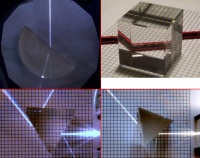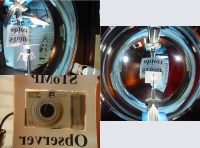



 Reality Viewer
Reality Viewer
These are not simulations as such, but a viewer and material to show photographically what happens in various experimental situations as particular parameters are changed. Topics are currently in geometrical optics, including refraction, total internal reflection, reflections in single and multiple plane mirrors, and concave and convex mirrors used for imaging. The "reality" part of the title is to show that these are not simulations or animations, but are showing real-life, albeit in a captured mode. Some of these sequences are also available in the SToMP (Software Teaching of Modular Physics) package.
The image alongside shows the view of a pencil through a glass cube, and also the generic mode of operation of the program. In the operating program, by pressing on the middle arrow, the cube will be rotated left and right again automatically. The adjacent buttons will pause or stop this mode. By pressing on the footstep icons the cube can be rotated one frame at a time, right or left. The arrows adjacent to the footsteps will rotate the cube as far as it is able in the two different directions. Alternatively, the cube may be rotated by pressing on the mouse button while dragging the mouse across the image.
The files here can be downloaded to a PC, and then when requested will
install the viewer and pictures onto your machine. They may be accessed
then via the start menu -> programs under LTSN applications. The exe files
to be downloaded range in size from 4.5 to 11 MB.

Refraction in a semicircular glass prism, a triangular prism, and in a glass
cube.
Also shows total internal reflection.
Download installation exe file for the four scenarios.

Reflections as viewed in a single, double, and corner-cube mirror set. As
the single mirror is moved in angle, we see the reflected surroundings change.
As the perpendicular pair of mirrors is moved around an axis along their meeting
edge we see that the double reflection always results in the camera being at the
vertex of the pair of mirrors. For three mirrors we have a
retro-reflector, and as these mirrors are moved around an arbitrary axis we see
that the image of the camera always remains at the vertex of the three mirror
system.
Download installation exe file for the three scenarios.

Reflections as viewed in a concave hemispherical mirror. Choose from
viewing the moving object and image head on or side on, or move the
observer-come-object and see what happens. The first two look like a good
way of seeing exactly what happens in this imaging system. The last is
maybe best left as a problem for the student to interpret!
Download the installation exe file
for the three scenarios.

Laser beam reflecting off the three mirrors in a retro-reflector (corner-cube).
The mirror-set was placed in water with light-scattering particles in order to
make the beam visible. The most clearly visible beam is not always
(never?) the incoming beam, and is sometimes the reflection of the scattered
light from one of the beams. However, if you determine which is the input
beam (always fixed in same place), it is clear that the retro-reflected beam
(after two reflections) always comes out of the system parallel to the incident
beam.
Download the installation exe file for the two views.
These materials were developed by Dr Dick Bacon at the University of Surrey, and have been licensed for use in the UK HE community by funding from a development grant awarded by the Physical Sciences Centre of the Learning and Teaching Support Network.
Acknowledgement and Disclaimer.
Return to SIG - Simulations in Physics and Astronomy Home Page